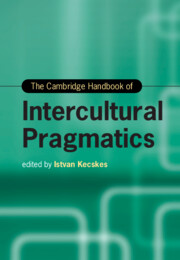Book contents
- The Cambridge Handbook of Intercultural Pragmatics
- Cambridge Handbooks in Language and Linguistics
- The Cambridge Handbook of Intercultural Pragmatics
- Copyright page
- Contents
- Figures
- Tables
- Acknowledgment
- Contributors
- Introduction The Rise of Intercultural Pragmatics
- Part I Theoretical Foundation
- Part II Key Issues in Intercultural Pragmatics Research
- Part III Interface of Intercultural Pragmatics and Related Disciplines
- Part IV Intercultural Pragmatics in Different Types of Communication
- 21 Visual and Multimodal Communication across Cultures
- 22 Intercultural Teamwork via Videoconferencing Technology: A Multimodal (Inter)action Analysis
- 23 Intercultural Communication in Computer-Mediated Discourse
- 24 Intercultural Aspects of Business Communication
- 25 Intercultural Pragmatics in Healthcare Communication
- 26 Academic and Professional Discourse in Intercultural Pragmatics
- 27 The Dynamic Model of Meaning Approach: Analyzing the Interculturality of Conspiracy Theory in Far-Right Populist Discourses
- Part V Language Learning
- Index
- References
27 - The Dynamic Model of Meaning Approach: Analyzing the Interculturality of Conspiracy Theory in Far-Right Populist Discourses
from Part IV - Intercultural Pragmatics in Different Types of Communication
Published online by Cambridge University Press: 29 September 2022
- The Cambridge Handbook of Intercultural Pragmatics
- Cambridge Handbooks in Language and Linguistics
- The Cambridge Handbook of Intercultural Pragmatics
- Copyright page
- Contents
- Figures
- Tables
- Acknowledgment
- Contributors
- Introduction The Rise of Intercultural Pragmatics
- Part I Theoretical Foundation
- Part II Key Issues in Intercultural Pragmatics Research
- Part III Interface of Intercultural Pragmatics and Related Disciplines
- Part IV Intercultural Pragmatics in Different Types of Communication
- 21 Visual and Multimodal Communication across Cultures
- 22 Intercultural Teamwork via Videoconferencing Technology: A Multimodal (Inter)action Analysis
- 23 Intercultural Communication in Computer-Mediated Discourse
- 24 Intercultural Aspects of Business Communication
- 25 Intercultural Pragmatics in Healthcare Communication
- 26 Academic and Professional Discourse in Intercultural Pragmatics
- 27 The Dynamic Model of Meaning Approach: Analyzing the Interculturality of Conspiracy Theory in Far-Right Populist Discourses
- Part V Language Learning
- Index
- References
Summary
This chapter analyzes how the Great Replacement conspiracy theory is exploited in far-right discursive strategies. Indeed, the common ground and/or collective narratives identified in discourses such as the Great Replacement theory have been created through re- or de-construction of current news, such as the influx of migrants. We draw on the Dynamic Model of Meaning theory, combining the theoretical concept of (emergent) common ground – fundamental to intercultural pragmatics–and the notion of proximization. Our data comprises Marine Le Pen interviews, Viktor Orbán speeches, and Matteo Salvini tweets, where we examine various aspects of their narratives as well as the specific contextualization. Our analysis reveals both common ground and cross-cultural variation in the conspiracy narratives disseminated by these far-right leaders: inferences vs. directness; national history vs. doomed future. We conclude by suggesting that such narratives work as metaphor scenarios and could, in fact, represent covert hate speech against a specific community. Moreover, these narratives function as useful political arguments, since they arouse strong emotions against the declared enemies of populists. While a rational and well-documented counter-discourse is needed to answer such strategies, it is crucial to both deconstruct and understand the beliefs underlying the emotions that lead a person to trust such beliefs.
- Type
- Chapter
- Information
- The Cambridge Handbook of Intercultural Pragmatics , pp. 711 - 738Publisher: Cambridge University PressPrint publication year: 2022



